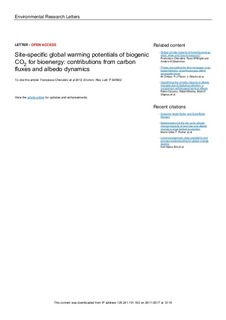| dc.contributor.author | Cherubini, Francesco | |
| dc.contributor.author | Bright, Ryan M. | |
| dc.contributor.author | Strømman, Anders Hammer | |
| dc.date.accessioned | 2017-11-29T09:58:27Z | |
| dc.date.available | 2017-11-29T09:58:27Z | |
| dc.date.created | 2013-01-28T13:06:26Z | |
| dc.date.issued | 2012 | |
| dc.identifier.citation | Environmental Research Letters. 2012, 7 (4), . | nb_NO |
| dc.identifier.issn | 1748-9326 | |
| dc.identifier.uri | http://hdl.handle.net/11250/2468448 | |
| dc.description.abstract | Production of biomass for bioenergy can alter biogeochemical and biogeophysical mechanisms, thus affecting local and global climate. Recent scientific developments have mainly embraced impacts from land use changes resulting from area-expanded biomass production, with several extensive insights available. Comparably less attention, however, has been given to the assessment of direct land surface–atmosphere climate impacts of bioenergy systems under rotation such as in plantations and forested ecosystems, whereby land use disturbances are only temporary. Here, following IPCC climate metrics, we assess bioenergy systems in light of two important dynamic land use climate factors, namely, the perturbation in atmospheric carbon dioxide (CO2) concentration caused by the timing of biogenic CO2 fluxes, and temporary perturbations to surface reflectivity (albedo). Existing radiative forcing-based metrics can be adapted to include such dynamic mechanisms, but high spatial and temporal modeling resolution is required. Results show the importance of specifically addressing the climate forcings from biogenic CO2 fluxes and changes in albedo, especially when biomass is sourced from forested areas affected by seasonal snow cover. The climate performance of bioenergy systems is highly dependent on biomass species, local climate variables, time horizons, and the climate metric considered. Bioenergy climate impact studies and accounting mechanisms should rapidly adapt to cover both biogeochemical and biogeophysical impacts, so that policy makers can rely on scientifically robust analyses and promote the most effective global climate mitigation options. | nb_NO |
| dc.language.iso | eng | nb_NO |
| dc.publisher | IOP Publishing | nb_NO |
| dc.relation.uri | http://iopscience.iop.org/1748-9326/7/4/045902/pdf/1748-9326_7_4_045902.pdf | |
| dc.rights | Navngivelse-Ikkekommersiell-DelPåSammeVilkår 4.0 Internasjonal | * |
| dc.rights.uri | http://creativecommons.org/licenses/by-nc-sa/4.0/deed.no | * |
| dc.title | Site-specific global warming potentials of biogenic CO2 for bioenergy: contributions from carbon fluxes and albedo dynamics | nb_NO |
| dc.type | Journal article | nb_NO |
| dc.type | Peer reviewed | nb_NO |
| dc.description.version | publishedVersion | nb_NO |
| dc.source.pagenumber | 11 | nb_NO |
| dc.source.volume | 7 | nb_NO |
| dc.source.journal | Environmental Research Letters | nb_NO |
| dc.source.issue | 4 | nb_NO |
| dc.identifier.doi | 10.1088/1748-9326/7/4/045902 | |
| dc.identifier.cristin | 998759 | |
| dc.relation.project | Norges forskningsråd: 193817 | nb_NO |
| dc.description.localcode | © 2012 IOP Publishing Ltd. Content from this work may be used under the terms of the Creative Commons Attribution-NonCommercialShareAlike 3.0 licence. | nb_NO |
| cristin.unitcode | 194,64,25,0 | |
| cristin.unitname | Institutt for energi- og prosessteknikk | |
| cristin.ispublished | true | |
| cristin.fulltext | original | |
| cristin.qualitycode | 1 | |

